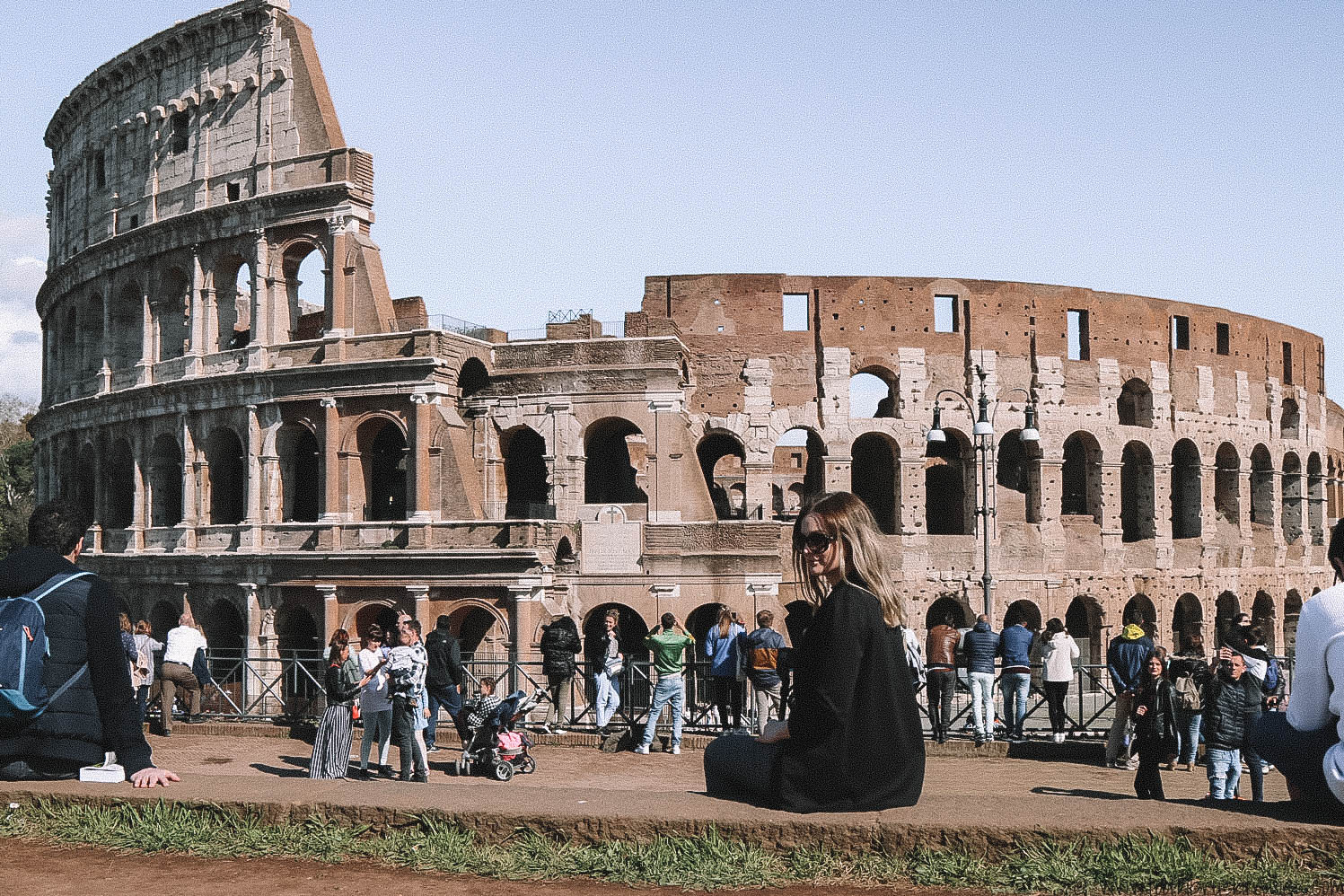You can’t picture Rome without the Colosseum.
Tall, magnificent and steeped in history both culturally and visually.
The Colosseum has been in films, music videos and fashion shows so the Colosseum, otherwise known as Colosseo, is quite the monument!
It’s iconic.

So obviously when I flew to Rome, I had to go and see it.
I thought I had left my hotel early enough, but as I walked towards the entrance, I quickly realised that was not the case. The queue was lengthy—but this girl’s English, and if I can queue for teabags like a total stereotype, then I can absolutely queue for this icon.
I took my place in the queue in the beaming hot morning sun, armed with a backpack full of goodies, (I’m always packing when it comes to snacking!) and waited for my turn.

As I stood there in the heat, grateful for every moment I was able to wait in a shaded part, I found myself wondering why I didn’t book a tour for the Colosseum. You see, the queue for tours are much smaller, and as it turns out (something I didn’t realise at the time) you get access to areas that general admission doesn’t include. Such as the dungeons beneath the Colosseum and the viewpoint on the highest tier outside. It’s also much, much quieter. But that wasn’t something I knew until after.
So let’s rewind a little, shall we?
All the way back to 69 AD.
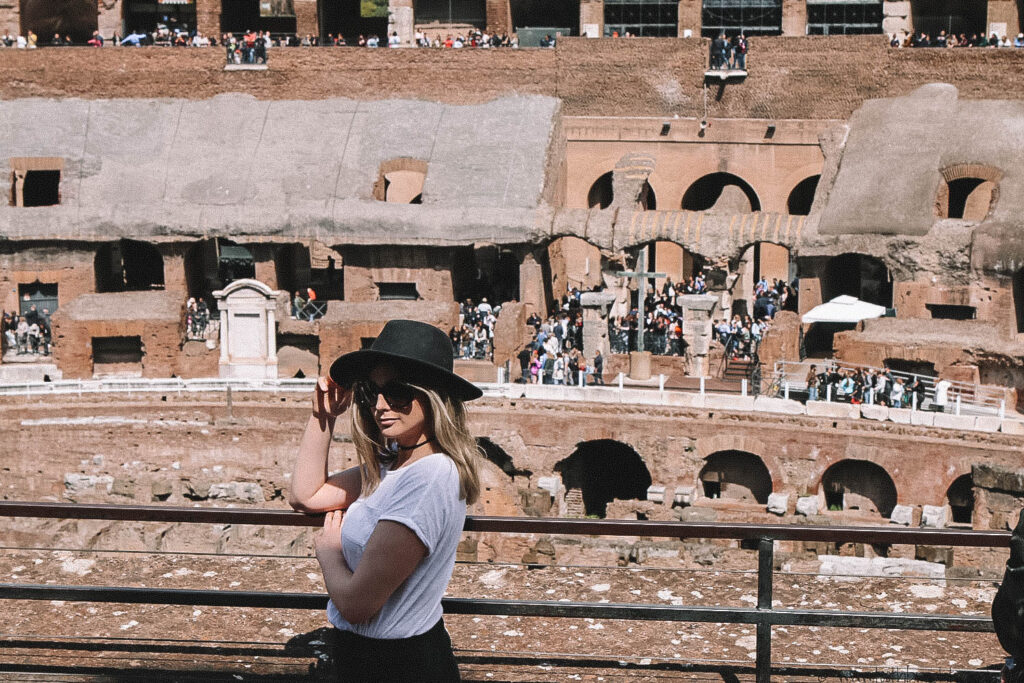
The Colosseum was the super dome, it was entertainment that came to you: a hub for all things violent. And it came about due to Vespasian Flavius.
You see, Vespasian had been made emperor, and his predecessor Nero was a bit of a d*ck.
Nero was known for his debauchery, persecution of Christians, political murders and for letting Rome burn in the great fire of 64 AD. He was greedy, entitled and liked to flaunt his wealth—like when he built Domus Aurea; a large landscaped palace complete with a man-made lake.
Domus Aurea loosely translates to Golden Palace, but it was known as the pleasure palace. Vespasian Flavius wanted to create a bold statement that showed he was nothing like Nero. He considered himself the Anti-Nero. So he destroyed most of the palace (some parts can still be seen today), filled the lake and built the Colosseum on top of where the lake once lay.
Emperor Vespasian Flavius waited a year as emperor before ordering the construction of the Colosseum, and it’s estimated that the construction began around 72 AD. It was financed by selling precious relics which were stolen from a Jewish temple during the spacing and sacking of Jerusalem, something which was commemorated on the Arch of Titus, situated between the Roman Forum and the Colosseum.

After the stealing spree was complete, they decided that the victory wasn’t quite enough, and so they bought back 60,000 Jewish captives from that campaign, to build the amphitheatre.
Before it was known as the Roman Colosseum, it was known as the Flavian Amphitheatre, and it was made out of two back-to-back greek theatres to create its circular shape. However, it’s believed that this design was changed further to create the oval shape you see today—and that it was changed to make for prime viewing for all the bloodshed.
After all, a square design would have meant corners. Which meant people would have got stuck in the corners and died quicker. Which for the Romans who wanted morbid entertainment, was not a good thing. So the oval shape enabled the view to continue no matter which angle people were viewing the bloodshed from.

It took tons of concrete, and the hauling of huge travertine building blocks from a quarry that was 20 miles away to get the Colosseum started. The heavier, more expensive materials such as limestone were used for the base as they were most sturdy. And as the levels get higher, the materials got cheaper as they became lighter in weight. The heavy blocks were moved by sheer force, group effort and were hauled up by the Romans sophisticated wooden cranes and devices made for lifting.
Considering the technology we have available today, it’s pretty incredible that they were able to create such designs out of wood!
In just 8 years the imposing structure stood 160 feet tall, dwarfing all of its surroundings, and as I stood in the centre looking down at what lay below, I felt it.
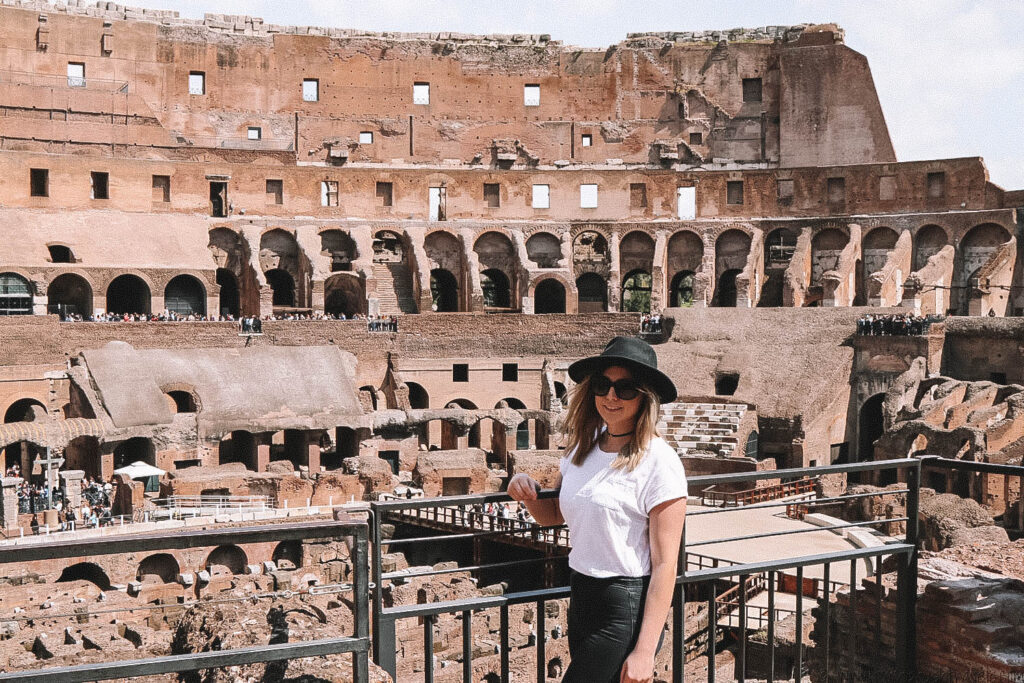
The Roman Colosseum is the tallest ancient Roman structure ever built. I mean, it was the amphitheatre of the capital so it had to be magnificent. A humble amphitheatre simply would not do! And as Rome was larger and richer than many of its Italian counterparts, it needed something which symbolised power, wealth and engineering. Which I think it’s fair to say it achieved.
Unfortunately, whilst Vespasian commissioned the Colosseum to be built, he didn’t live long enough to see the Colosseum open to the public in 80 AD, as he and died just months before. His natural-born son, Titus, had the honour of launching the Colosseum, who started the celebrations with a grand opening which spanned 100 days. 100 days filled with games and bloodshed from the gladiatorial battles and fights between animals. So much bloodshed, that when they designed the base of the Colosseum, it was made out of a combination of wood and sand, so that the sand could absorb the blood spill.
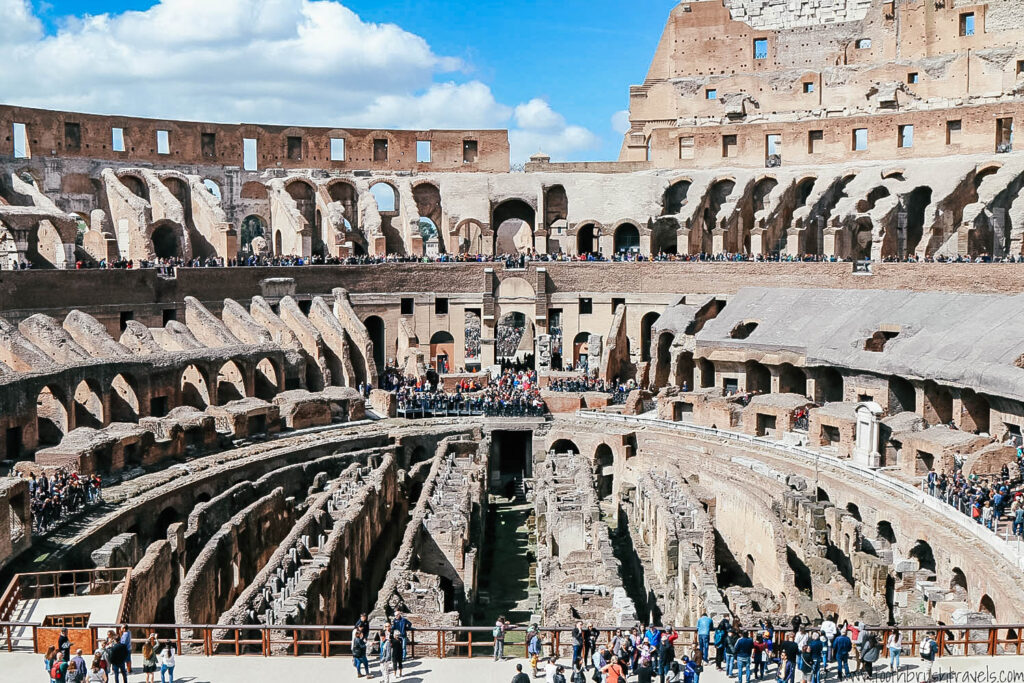
The Colosseum was a roaring success. Fitting a space that could hold up to 80,000 spectators, the seating arrangements at the Colosseum were precisely organized. There was a balustraded section for the authorities, a private entrance for the Emperor and his entourage which lead to the imperial box, and for everybody else, there were steps which were organised by both class and citizenship. Women and non-citizens were seated together on wooden bleachers and slaves had to stand on the (now missing) terrace which was situated above the bleachers.
The Colosseum set a new standard for design, not just for the intricate corridors and staircases which were used. But because they were able to get 80,000 Romans in and out of the Colosseum in record time—something which was made possible by the numbers etched above each entrance. Each ticket would state an entrance number to use—a design we still use today to help people find their seat section in football matches, concerts and so much more.
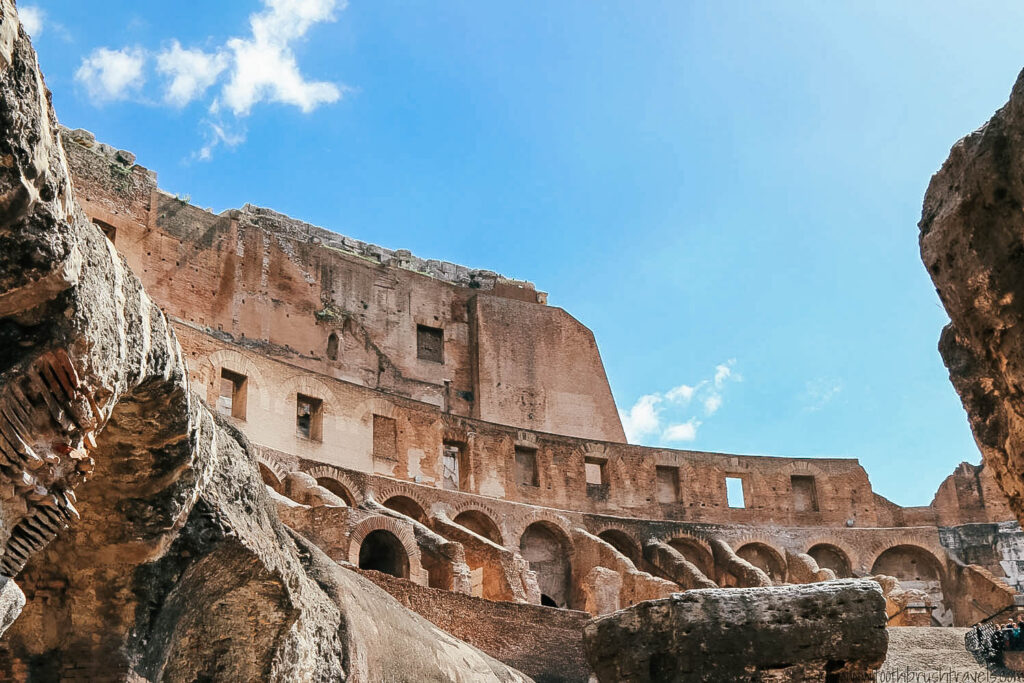
In its prime, the Colosseum was an architectural marvel. It had 110 drinking fountains, 2 restaurants a viewing area which accommodated 80,000 spectators and even had a retractable roof which was made out of canvas. Operated by navy sailors stationed around the top of the arcade, the retractable roof was moved according to the position of both the sun and wind, to provide shade.
The entertainment which happened in the Colosseum, however, was morbid. At least by today’s standards. It was violent, bloody and for ancient Romans? Completely and utterly thrilling. It was the ultimate spectacle awed by engineering prowess which advanced a nation.
As I walked through the corridors, stopping on the viewing platforms to look at what lay below and observe, I tried to imagine what it must have looked like when viewing a game from up there. But then I realised it was a thought I couldn’t spend too long dwelling on, as it seemed insane.
One such example, was the opening games—which saw 100 days of utter carnage, to the point that 5,000 animals were killed in one day. Thousands of gladiators and prisoners lost their lives in a level of bloodshed seen outside only in war. But it was considered entertainment.
The gladiator fights were the Roman Colosseum’s biggest draw but they weren’t always the main event. Thanks to a few internet research binge, I learnt that it’s been recorded by several ancient writers that there were even naval battles in the Colosseum.
NAVAL BATTLES!
Can you believe that? I couldn’t. But it was in three documentaries, countless Youtube videos and multiple articles online so it must be true.
Apparently, the naval battle scenes were recreated with battleships inside the Colosseum which was made possible due to the incredible underwater plumbing systems the Romans created. The Colosseum would be flooded by diverting water to the arena from a nearby aqueduct and would fill the base of the Colosseum to shallow levels, which were deep enough for boats and drowning. Because it’s the Colosseum so of course there’s fighting and death.
The Colosseum is an epic construction, but if we’re being honest, it was basically a giant death oval.
The Romans would flood the base of the Colosseum via intricate drain systems, something which an architect called Christiano thinks he found conclusive proof of. The underwater plumbing system was made up of various ducts and a holding tank which was a direct line to the aqueduct. Once the Colosseum was filled, the water was then drained, releasing the floodwaters into the Tiber River.
However, these naval battles weren’t as popular as the gladiator battles, and so after a decade they were phased out and the Colosseum was renovated to create a two-story substructure called a hypogeum. Which essentially translates to “underground” and refers to the vast network of underground cells, tunnels, rooms and passages you can still see to this day.
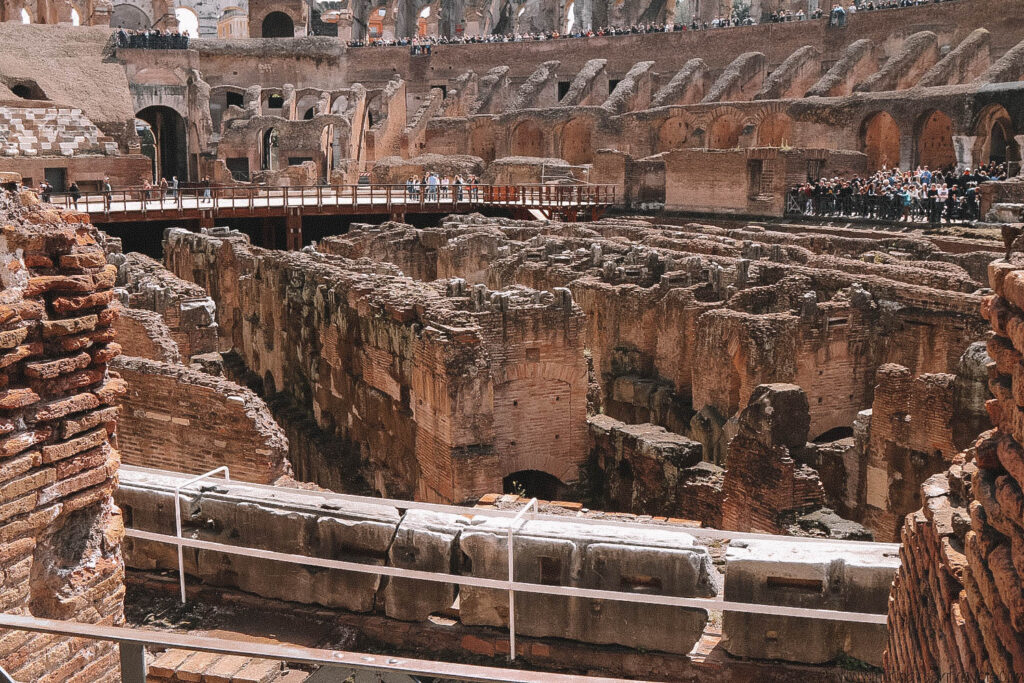
But this hypogeum was different. Because it was here that the trap doors were designed so that tigers could pop out of nowhere for a surprise slaughter.
Can you imagine being stuck in a fight and then a tiger jumps out at you?
It was in the hypogeum that the support system for the animals lay. Including cages for the animals and criminals, lion runs and areas for the gladiators to sharpen their tools and torment the animals. It was essentially a hype zone. A place where the fighters and animals would be before the show. It was backstage. Only it’s nothing like the theatre shows we see today, because there was no musical whimsy, the soundtrack in the Colosseum was screams and the smell was death.
The entertainment schedule in the Colosseum was typically, as follows:
Morning: Wild beast slaughters.
Afternoon: Criminal crucifixions.
Evening: Gladiator combat.
It was basically bloodshed from morning to night.
It’s haunting when you think about the mass death which happened within this oval. It’s estimated that over a million people lost their lives here and species, such as Balkan Lions and the North African elephants, were driven to extinction. In recent years, remains of some gladiators have been found, and you can see the damaged bones and punctured skulls which resulted in their death in battle.
How much of the Colosseum’s history is fact and how much is a myth, we’ll never truly know.
Stories such as criminals being dressed in wings and catapulted across the arena to recreate the Greek myth of Icarus flying too close to the sun, make it hard to tell.
A tour through the Colosseum delivers some epic facts.
But regardless of how you choose to explore, the Colosseum is a place that’s been restored and cared for since its erection, with many renovations happening between then and now. The Colosseum may not be what it once was (thankfully, I’m pretty sure population numbers would decrease drastically if it was!). But it’s still interesting to walk around and study the engineering which made this place possible.
I always feel strange visiting places which have caused so much death. And the Colosseum spilt blood for centuries. Using people’s mortality as entertainment. But one thing’s for sure, the Roman Colosseum is no longer a place of death. It’s a place brimming with life as thousands of visitors visit each hour—and if you want to be one of them my advice is as follows:
Book a Tour!
As mentioned above, you not only get to skip the majority of the queue, but you get access to elements others aren’t able to.
Wear Comfortable Shoes.
There’s lots of walking to be done, and your feet will thank you.
Take Water
Hot weather and dense crowds are a recipe for disaster, so you should stay well hydrated! Possibly also take a hat to help keep you cool. I say possibly, because sometimes the wind is annoying.
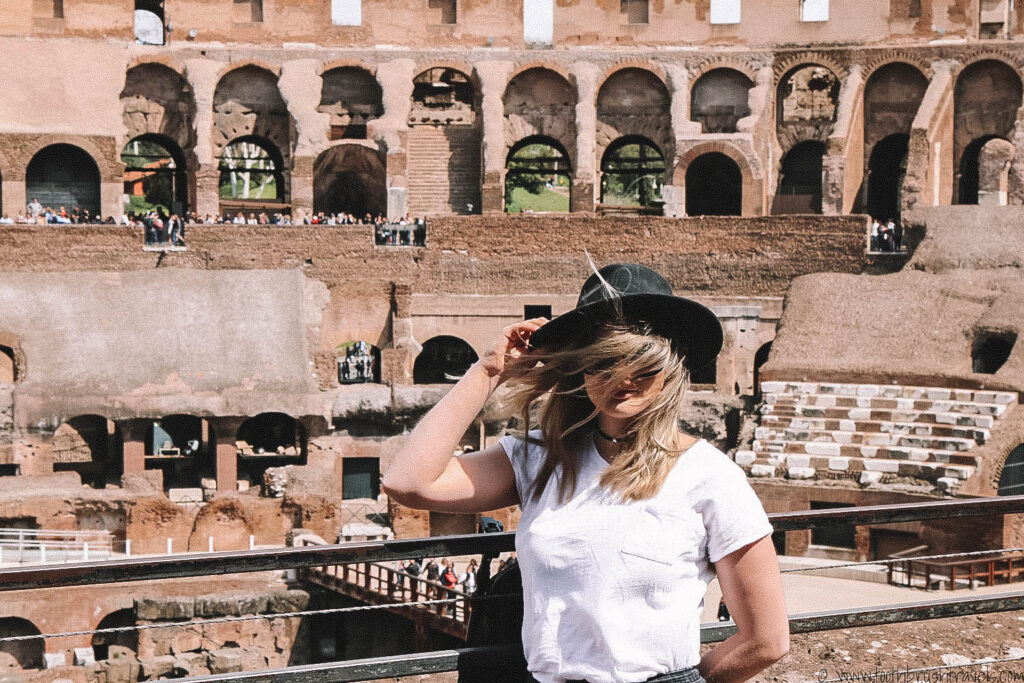
Happy exploring!
